ROCKLAND – Although he has lived with these Rockwell Kent paintings in his Tenants Harbor home for many years, Jamie Wyeth acts as if he is seeing them for the first time when he walks into the gallery in the Wyeth Center at the Farnsworth Art Museum.
He expresses childlike amazement at Kent’s brilliant sunset painting, “Late Afternoon, Monhegan Island.” It casts a yellow-orange glow over the gallery entrance, beckoning viewers with its warmth. One can almost feel the heat of the searing ball going down.
Wyeth steps back to take it all in. He calls it the “seminal painting” of Monhegan, and prescribes Kent as the “pre-eminent painter who’s ever painted out there. I thought his works went beyond anything that had been done out there. Very simple and abstract. I became wild about his work.”
The Farnsworth celebrates the bond between these two artists with its latest exhibition, “Jamie Wyeth, Rockwell Kent and Monhegan.” The show includes several recent Wyeth paintings from the island as well as almost a dozen large Kent canvases, half of which are owned by Wyeth himself.
But that is not all of Kent’s handiwork that he owns. With proceeds from early-career sales in New York, Wyeth purchased the house that Kent built on the island, which sits 10 nautical miles from Rockland and has lured artists for more than 150 years.
Although the two artists never met, they exchanged friendly letters in 1970, the year before Kent died.
Wyeth wrote to Kent to tell him he had recently purchased one of his paintings. Kent wrote back, expressing delight that one of his works had found a home with young Jamie Wyeth and that Wyeth had also purchased Kent’s island home.
“About the situation of the house,” Kent wrote, “you will be interested to know that when I built it so very close to the sea, I was warned by old Monheganers that it would never stand up against stormy weather. But since there was grass growing in the scanty soil on that site, I was certain the sea would never reach it.
“But for a year or two after I built the house, I had nightmares over its being washed away and of myself swimming about in the wreckage.”
INSPIRATION FOR BOTH ARTISTS
The Farnsworth exhibition honors the shared sense of place that bonds these artists, says curator Michael K. Komanecky. He got the idea for this show the first time he visited Wyeth and his wife, Phyllis, at their home in Tenants Harbor. He was surprised to see so many important Kent paintings in the hands of a single collector, let alone a painter with the stature of Wyeth.
Given Wyeth’s own longtime infatuation with Monhegan, it made sense to bring these two together, Komanecky says.
But, he warns, “This is not an exhibition that intends to suggest any kind of influence of Rockwell Kent on Jamie Wyeth, other than Monhegan serving as an incredible source of inspiration for both of them over a long period of time.”
Kent came to Monhegan in 1905 at the suggestion of his teacher and mentor, Robert Henri. He returned many times over the years, and some years stayed over through the winter. He loved the place, respected the fishermen and year-round residents, and did his best to blend in without being intrusive.
Wyeth has done much the same. He first came to Monhegan in the 1950s with his father, the late painter Andrew Wyeth. They sketched together, and some of Jamie’s early Monhegan paintings — a bronze bell in particular — became some of his best-known work.
After Jamie bought Kent’s house, he returned regularly, and still spends considerable time on the island each year.
Most of Wyeth’s work in this show is recent, from the last decade or so. Whereas Kent painted sweeping landscapes of the island, Wyeth focuses on tight portraits of local people and unusual scenes. Both avoid the iconic views of lobster boats and buoys favored by many island painters.
Kent’s passionate avoidance of common subjects impressed Wyeth from the get-go, and helped steer him toward his own subject selection, he says.
“The problem with Monhegan is that it is such an emblematic place,” Wyeth says, gesturing at Kent’s light-imbued “Monhegan Headlands” from 1905. “Kent stayed away from all of that. He just did simple, elemental shapes.
“What fascinated me about this show, I think we are quite different painters. It’s phenomenal that an island could produce two entirely different sets of views, but both are not the usual typical things of buoys hanging and fishermen and that sort of thing. I am honored to be hanging in a gallery with his work. I wish I had met him.”
‘I HAVE TO PAINT THIS’
Wyeth has his own set of dreams from Monhegan, and they are portrayed here in two unusual paintings.
In 2009, soon after his father’s death, Wyeth dreamed he saw his father; his grandfather, N.C. Wyeth; Winslow Homer and Andy Warhol standing on the rocks at White Head in a storm.
N.C. and Andrew obviously share Wyeth’s genetic lineage. Homer was Maine’s best-known seascape painter, though he never painted at Monhegan. And Warhol was a longtime friend. These four are bound by their connections to Jamie, either directly or through their painting pedigrees.
Painting on cardboard, Wyeth depicts Warhol standing away from the raging sea. Homer stands closer to the water’s edge, walking stick in hand. N.C. and Andy are snug up to the surf, one pointing out a distant feature to the other. The stormy water is a gurgle of white, brown and pink.
In another painting, “A Recurring Dream,” Andy and N.C. stand together in the same spot.
Maine writer Stephen King owns a third painting in this dream sequence.
Wyeth says he was spiritually moved to make these works, though he is not sure he understands them — and never intended for them to be shown publicly.
“Some dreams are not dreams, they are so vivid,” he explains. “I said, ‘I have to paint this.’ They are very odd paintings. When I look at them now, I think, ‘What the hell was in my mind?’“
There are several other odd paintings in this show: An image of pumpkins tossed from the cliffs at the Headlands, floating through the air like balloons; of dogs taking a dip in the water, their eyes fixed in cold stares at the viewer; of another dog staring bug-eyed underneath a great white shark jaw that hangs in display on a wall.
All are interesting and unique, revealing Wyeth’s humor and personality. And none is the kind of Monhegan painting we have come to expect.
Perhaps the most unlikely painting in the show is “Battleship,” from 2002.
In it, Wyeth places an island boy, who models for him regularly, with a group of other island kids as they watch a U.S. warship motor by the island’s southern edge. The sky is a brilliant late-day yellow, and it casts the ocean in an equally yellow blanket.
With its tones, “Battleship” shares a similar feeling as Kent’s brilliant “Late Afternoon, Monhegan Island.” But Wyeth’s painting goes someplace else altogether.
For island residents, battleships crossing their path is a common scene. But it is not something that visitors and Sunday painters often experience, Wyeth says.
“This happens when they trial the ships offshore. It happens all the time,” he says. “They literally come by Monhegan on their sea trials. This is when the ships are still owned by the people who built them, not by the Navy. These things glide by Monhegan and dwarf everything.”
Much like the setting sun.
Staff Writer Bob Keyes can be contacted at 791-6457 or:
bkeyes@pressherald.com
Twitter: pphbkeyes
Send questions/comments to the editors.


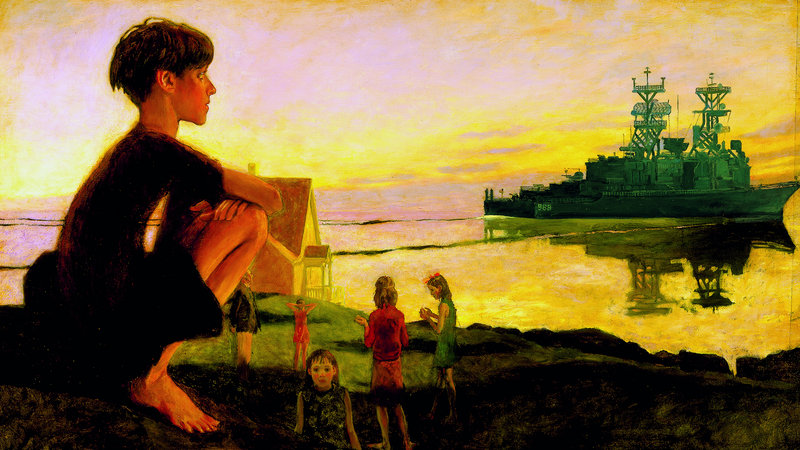
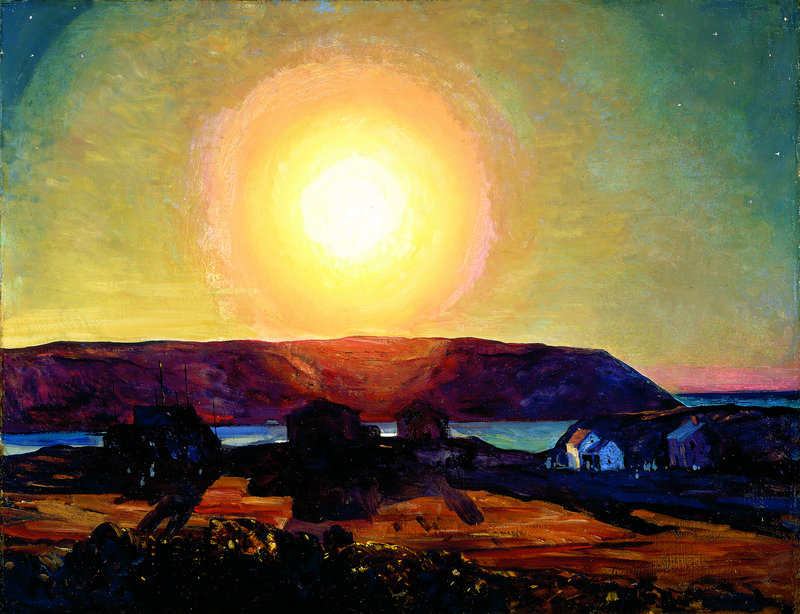
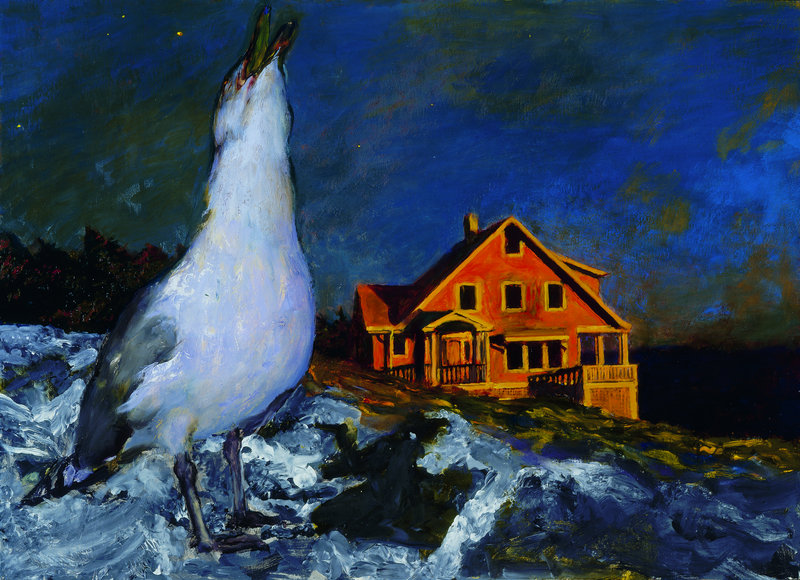
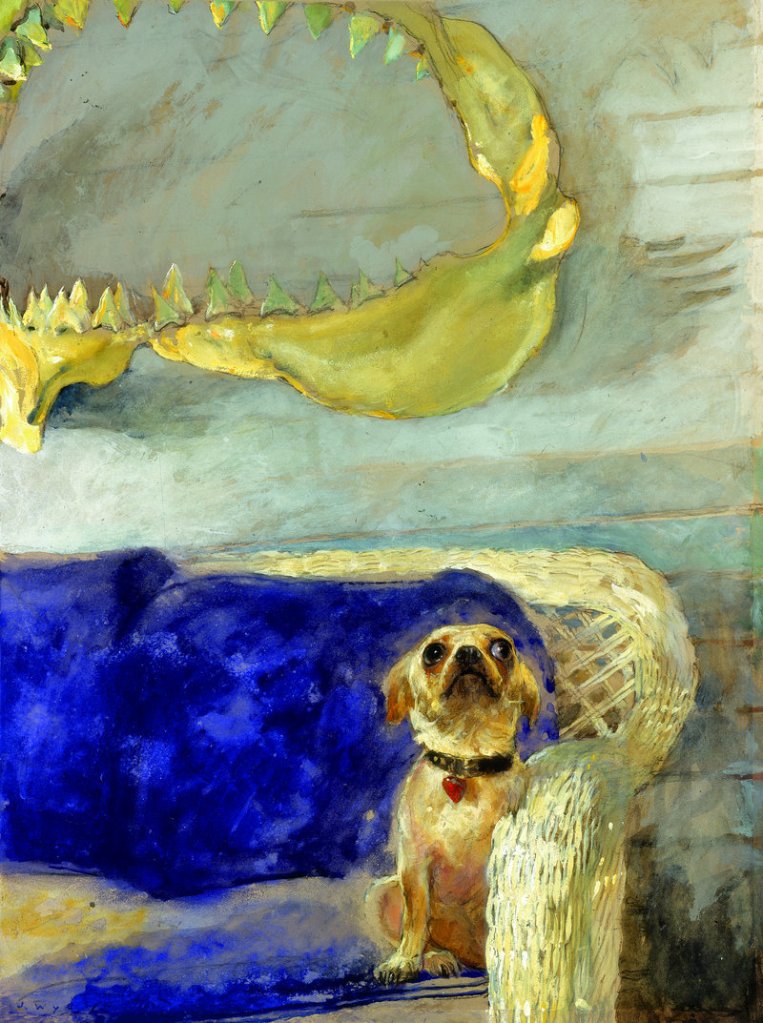
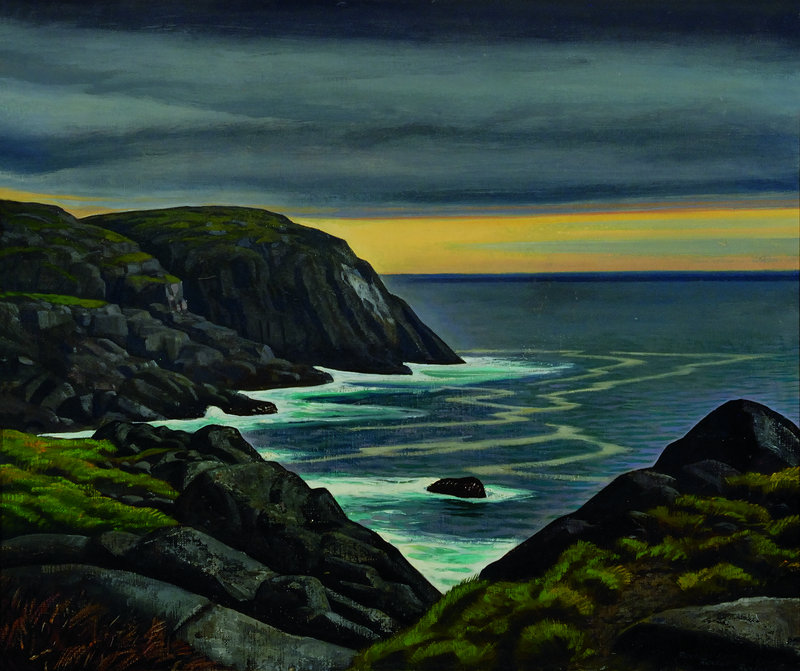

Comments are no longer available on this story